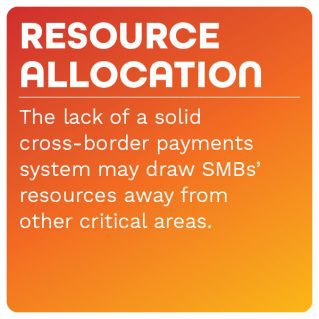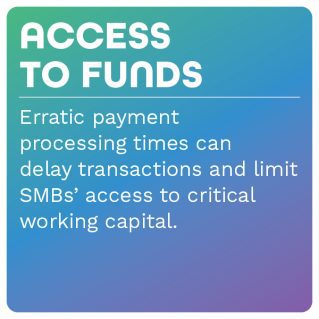Small to midsized businesses (SMBs) have a range of payment choices when deciding to launch operations internationally. While most SMBs globally launching will have some web presence, many may still use legacy payment methods to send and receive funds. Payments digitization helps SMBs grow internationally, but successful implementation has numerous challenges.
In “International B2B Payments: A Guide For Entrepreneurs And Digital Businesses,” a collaboration with Payoneer, we examine the role of digital payments in overcoming challenges as SMBs expand internationally.
SMBs find global success challenging to scale
For SMBs with a global virtual workforce, success may present its own challenges. According to the report, as SMBs find new ways to translate their business models into digital ventures, growth may complicate international transactions, leaving few resources to manage the day-to-day business tasks.
 As SMBs and entrepreneurs expand their workforces across borders to seek audiences abroad, they may face various difficulties, including managing multiple currencies, managing accounts payable (AP) and accounts receivable (AR) and ensuring that payments remain compliant with global regulations.
As SMBs and entrepreneurs expand their workforces across borders to seek audiences abroad, they may face various difficulties, including managing multiple currencies, managing accounts payable (AP) and accounts receivable (AR) and ensuring that payments remain compliant with global regulations.
The complexity of cross-border business is especially challenging for SMBs that depend on vendor relationships to fuel growth. Slow or erratic payments processes can cause credit issues and damage long-term business relationships. That makes payments digitization critical for SMBs seeking to launch or grow abroad.
Moving toward digital payments is a logical first step for SMBs seeking to grow their businesses across borders. International growth requires the ability to send and receive from any region in a secure, compliant fashion.
Efficiently managing B2B payments is a resource-intensive process

However, SMBs are unlikely to have the technical or human resources required to manage the digitization process independently. Preparing to send and receive business-to-business (B2B) payments digitally in multiple regions using a range of currencies may require the involvement of multiple banks and payments tools.
According to the report, creating this capability from scratch would mean coordinating with banks and payment services providers, as well as monitoring current and emergent compliance mandates for each region where a company does business — simply too much for most SMBs to accomplish.
For some SMBs, the answer is to seek a third-party solution that can streamline B2B payments through a single payments tool.
SMBs should be discerning when choosing a B2B payments solution
According to the report, the type of solution is key to SMB’s success. Businesses should look for a powerful global network of payments management services with connections to a robust banking infrastructure. When an SMB launches a cross-border enterprise, the chosen payment services provider should have access to a network that permits seamless, rapid region-to-region growth.
To learn more about how SMBs can leverage cross-border payment options, download the report.

